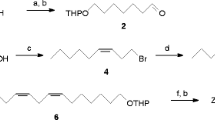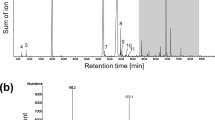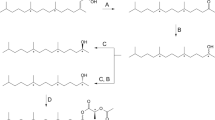Summary
From sting extracts ofApis dorsata andA. florea, a substance was isolated which is active in alarm behaviour of both of these species but not ofA. mellifera andA. cerana. The active substance was identified as 2-decen-1-yl-acetate.
Similar content being viewed by others
References
R. Boch, D.A. Shearer and B.C. Stone, Nature195, 1018 (1962).
R.A. Morse, D.A. Shearer, R. Boch and A.W. Benton, J. apic. Res.6, 113 (1967).
N. Koeniger, J. Weiss and U. Maschwitz, in preparation.
H. Budzikiewicz, C. Djerassi and D.H. Williams, in: Mass Spectrometry of Organic Compounds, p. 184 and p. 468. Holden-Day, San Francisco 1967.
The average amount of 2-decen-1-yl-acetate per sting ofA. dorsata is about 6 μg andA. florea about 1 μg.
K. Nützel, in: Methoden der organischen Chemie, 4th ed., vol. 13/2a, p. 809. Ed. Houben, Weyl and Müller. Thieme, Stuttgart 1973.
J. Weiss, Apidologie, in press (1978).
Author information
Authors and Affiliations
Rights and permissions
About this article
Cite this article
Veith, H.J., Weiss, J. & Koeniger, N. A new alarm pheromone (2-decen-1-yl-acetate) isolated from the stings ofApis dorsata andApis florea (Hymenoptera: Apidae). Experientia 34, 423–424 (1978). https://doi.org/10.1007/BF01935900
Published:
Issue Date:
DOI: https://doi.org/10.1007/BF01935900




